| |
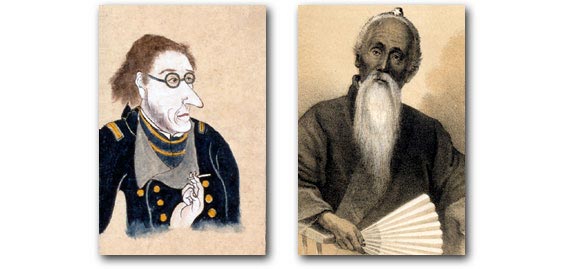 |
 S.
Wells Williams S.
Wells Williams |
Okinawan
official |
 |
 Shiryo
Hensanjo, University of Tokyo Shiryo
Hensanjo, University of Tokyo |
from
the official Narrative |
As already seen in their diverse renderings of Commodore Perry, Japanese
artists did not hesitate to resort to outright fantasy when drawing
portraits of the foreigners. Even when they were ostensibly drawing
“from life,” their attempts to capture the spirit or personality
of their subjects gave a touch of caricature to the resulting portrait.
We see this in an ostensibly realistic pair of paintings of Perry
and Commander Henry Adams, his second-in-command, for example,
as well as in anonymous woodblock portraits of a decidedly foppish
Adams and an alarmingly sharp-visaged “American Chief of the
Artillery-men.”
|
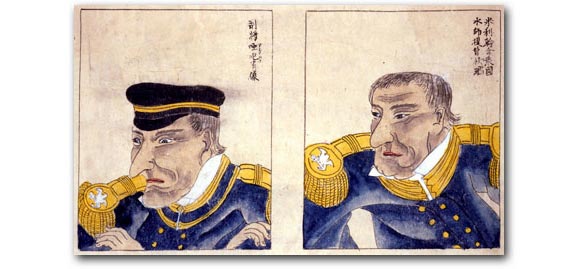 |
 Perry
(right) and Adams, ink and color on paper, 1854 Perry
(right) and Adams, ink and color on paper, 1854
Ryosenji Treasure Museum
|
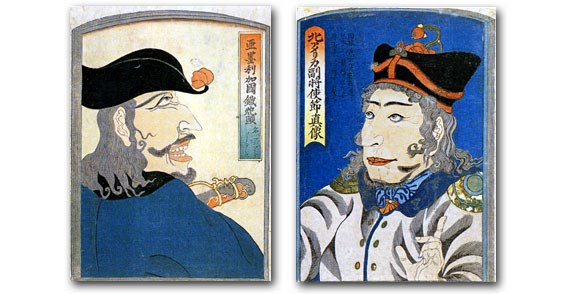 |
 Left:
“American Chief of the Artillery-men” Left:
“American Chief of the Artillery-men”
Right: “The North American Adjutant General (Adams)”
woodblock prints, ca. 1854
Peabody Essex Museum
|
Full-figure
renderings of the foreigners as they were observed in Kurihama or
Yokohama or Shimoda or Hakodate followed the same free style. Often
these figures were lined up in a row like a droll playbill for a cast
of characters who had chosen to strut their stuff on the Japanese
stage.
|
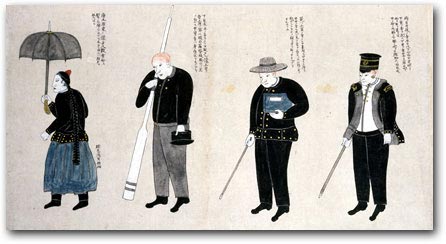 |
“Pictorial Scroll of Black Ships Landing at Shimoda” (detail)
Ryosenji Treasure
Museum |

“Pictorial Record of the Arrival of Black Ships” (detail)
ca. 1854
Ryosenji Treasure Museum |
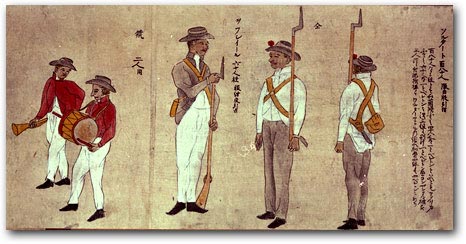 |
A
particularly dramatic cast of characters accompanied one of the monstrous
black ships introduced earlier, in the form of a gallery of nine individuals.
In addition to Perry, the accompanying text identified them (right
to left) as an interpreter, the crewman who sounded the ocean’s
depth, a high officer, the chief of the “rifle corps”
(marines), a navigator, a marine, a musician, and a crewman from a
“country of black people,” usually called upon “to
work in the rigging or dive in the sea.” Colorful and idiosyncratic,
they comprised a motley crew indeed.
|
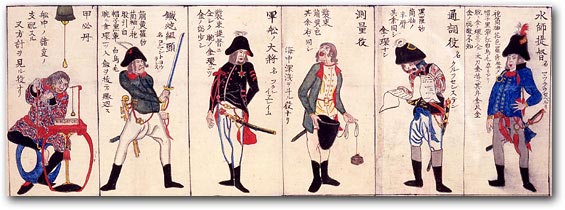 |

Detail from
“Black Ship and Crew”
ca. 1854
Ryosenji Treasure Museum
|
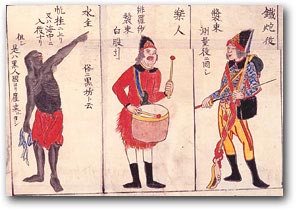 |
Some
sketches by Japanese artists were clearly drawn from direct observation,
with close and annotated attention to every article of attire and
piece of equipment.
|
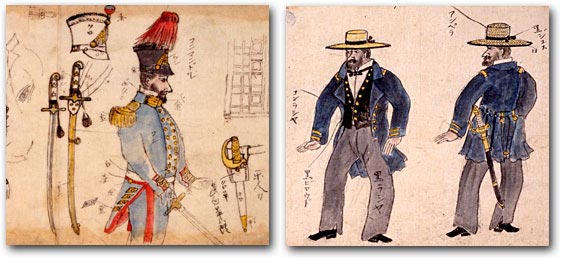 |
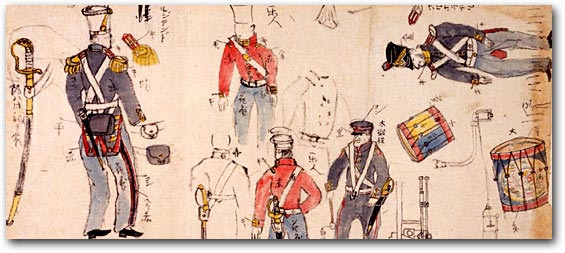 |
 From
an artist’s sketchbook, 1854 From
an artist’s sketchbook, 1854
Shiryo Hensanjo, University of Tokyo
|
The
most “realistic” run of portraits of the Americans dates
from March 8, 1854, when Perry landed in Yokohama to initiate his
second visit. Commissioned by the daimyo of Ogasawara, the original
sketches were drawn by Hibata Osuke, a performer of classical Noh
drama who studied under the famous woodblock artist Utagawa Kuniyoshi.
With some difficulty, Hibata managed to situate himself in the midst
of that day’s activities and record a great variety of subjects
and events.
Other artists subsequently copied his keenly observed renderings of
the commodore and five others: Commander Adams; Captain Joel Abbott;
S. Wells Williams, a missionary from China who knew some Japanese;
a Dutch-Japanese interpreter named Anton Portman (communication often
required using Dutch as an intermediary language between English and
Japanese); and Perry’s son Oliver, who served as his personal
secretary. The posing was highly stylized—all in half-profile—and
each subject possessed the prominent nose that set Caucasians apart
in Japanese eyes. At the same time, each was unmistakably imbued with
individuality.
|
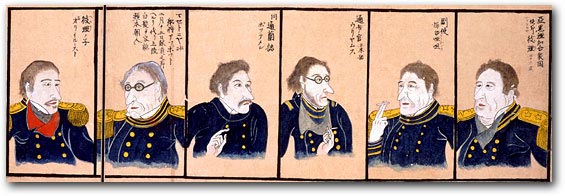 |
  Two
colored renderings based on Hibata Osuke’s 1854 sketches of
Perry and five others. From right to left (above): Commodore Perry, Commander Adams, English-Japanese
translator S. Wells Williams, translator Anton Portman, Captain Joel Abbot, and
Perry’s son Oliver Two
colored renderings based on Hibata Osuke’s 1854 sketches of
Perry and five others. From right to left (above): Commodore Perry, Commander Adams, English-Japanese
translator S. Wells Williams, translator Anton Portman, Captain Joel Abbot, and
Perry’s son Oliver
Shiryo Hensanjo, University of Tokyo
(above) Chrysler Museum of Art (below)
|
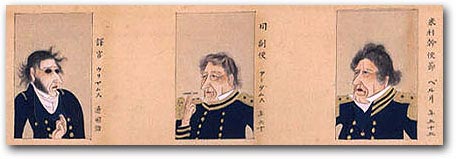 |
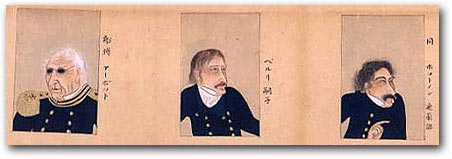 |
The
Americans brought a very different—and very recent—perspective
to their individual portraits. Where Japanese depictions of the foreigners
essentially came out of well-established rhetorical and pictorial
conventions, the Americans brought the eye of the camera. Two different
photographic processes—calotype and daguerreotype—had
been introduced in the West in 1839, and the latter dominated the
world of photography into the 1850s.
Daguerreotypes were distinguished by their grainless and exceptionally
sharp images, but had the disadvantage of producing a single, fragile,
non-reproducible original. There was no negative, and thus no possibility
of making multiple copies. Producing one of these plates involved
a complex (and toxic) chemical process, and was exceedingly time-consuming.
Although a daguerreotype camera was obtained by an enterprising Japanese
as early as 1848, it was the Perry mission that actually made the
first photographic portraits of Japanese.
The entertaining “Black Ship Scroll” rendering of three
Americans photographing a courtesan (seen in the previous section)
actually depicts the mission’s chief photographer, Eliphalet
Brown, Jr., and his assistants. Although Brown is known to have taken
more than 400 daguerreotypes of scenery and individuals,
all but a handful have been lost. Some were given to the individuals
who were photographed, and those brought back to the United States
were destroyed in a fire while the official report was being prepared
for publication.
The few originals that have come down to us—mounted in the heavy
gilt frames that commonly enhanced and protected these precious images—portray
samurai. Among them are depictions of Namura Gohachiro, an interpreter
summoned from Nagasaki; Tanaka Mitsuyoshi, a low-ranking guard in
Uraga; and officials in the new treaty ports of Hakodate and Shimoda.
|
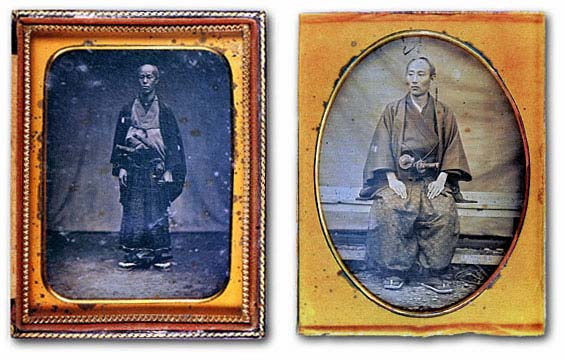 |
  Tanaka
Mitsuyoshi, a low-ranking guard in Uraga. Daguerreotype by Eliphalet Brown, Jr., 1854 Tanaka
Mitsuyoshi, a low-ranking guard in Uraga. Daguerreotype by Eliphalet Brown, Jr., 1854
Collection of Shimura Toyoshiro
 |
  Namura
Gohachiro, an interpreter summoned from Nagasaki. Daguerreotype by
Eliphalet Brown, Jr., 1854 Namura
Gohachiro, an interpreter summoned from Nagasaki. Daguerreotype by
Eliphalet Brown, Jr., 1854
Bishop Museum of Art
|
The
posed portraits of Namura and Tanaka, similar at first glance, have
subtle stories to tell. Barely visible behind Tanaka’s feet,
for example, is the foot of some sort of wooden stand—believed
to be a prop used to assist subjects in holding steady for the long
exposure that the daguerreotype process demanded. Additionally, whereas
Tanaka appears as the eye would see him (kimono folded left over right,
and swords carried on the left), Namura confronts us in reverse image
(kimono folded right over left, and swords on the right—where
a samurai, trained to fight right-handed, would be unable to draw
quickly). Since the daguerreotype produced a mirror image, it is Tanaka
who is the anomaly. To appear properly in the photo, he folded his
garment and mounted his sword improperly. Namura did not do this.
Another of Brown’s surviving “magic mirror” daguerreotypes
exposes, in and of itself, this same issue of how to pose. In this
daguerreotype, which has deteriorated over time, the seated bungo
or prefect of Hakodate holds center stage, while two retainers stand
behind him. Like Tanaka, the prefect maintained proper appearance
by reversing his sword and garment for the camera; and, like Namura,
his attendants did not bother to do so. As fate would have it, however,
the prefect’s fastidiousness did not carry over to the wider
world of publishing. The official Narrative contains a lithograph
of the same three men—apparently based on another daguerreotype
taken at the same sitting—in which the two aides have changed
sides, but so have the prefect’s sword and kimono-fold. Somewhat
inexplicably, all three men now appear to be improperly dressed and
armed.
|
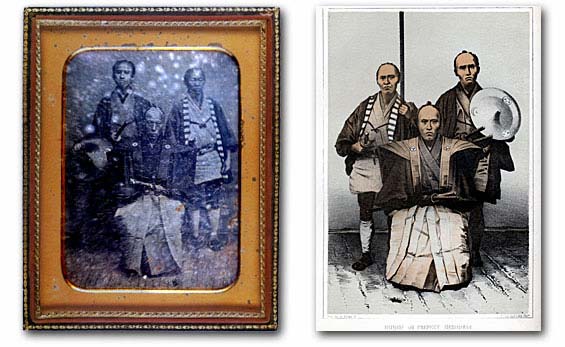 |
  Endo
Matazaemon, a local official in Hakodate, and his attendants. 1854
daguerreotype by Eliphalet Brown, Jr. and a near mirror-image lithograph of the three
men from the official Narrative of the Perry mission published in 1856 Endo
Matazaemon, a local official in Hakodate, and his attendants. 1854
daguerreotype by Eliphalet Brown, Jr. and a near mirror-image lithograph of the three
men from the official Narrative of the Perry mission published in 1856
Yokohama Museum of Art
|
Despite
the loss of Brown’s original work, the official record actually
contains a number of woodcut and lithograph portraits that are explicitly
identified as being based on his daguerreotypes. Thus, the camera’s
eye remains, even though the photographs themselves have disappeared.
Its focus falls not just on samurai, but on anonymous commoners as
well—and not just on the Japanese, but also on residents of
the Ryukyu (“Lew Chew”) Islands, which did not formally
become part of Japan until the 1870s.
|
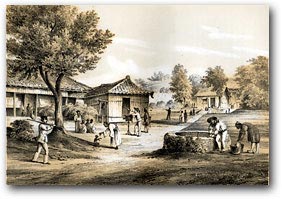 |
Like the official illustrations that included artists sketching and
painting, the Narrative actually gives us a subtle “double exposure”
of the photographer at work. Thus, close scrutiny of a bucolic illustration
by Heine titled “Temple at Tumai, Lew Chew” reveals Brown
at stage center preparing to photograph several seated figures.
|
| |
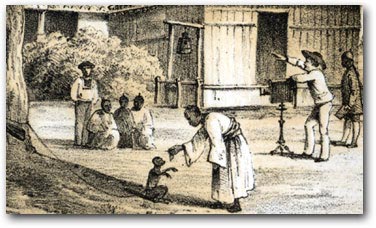 |
  “Temple at Tumai, Lew Chew” with Eliphalet Brown, Jr. preparing to take a daguerreotype portrait (detail at right) “Temple at Tumai, Lew Chew” with Eliphalet Brown, Jr. preparing to take a daguerreotype portrait (detail at right) |
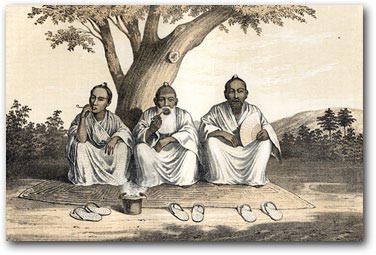
“Afternoon
Gossip, Lew Chew”
lithograph based on Brown’s daguerreotype
|
Some
twenty-plus pages later, we are treated to a charming, tipped-in lithograph
titled “Afternoon Gossip, Lew Chew,” depicting three men—surely
these very same subjects—seated on a mat beneath a tree, smoking
and seemingly at perfect peace with the world.
While
dignity pervades the individual portraits that grace the Narrative, informality such as
this is rare. Usually, those who held so still for so long—as
the slow daguerreotype process demanded—tend to seem immobilized,
almost frozen. They inhabit a world far removed from the animated,
colorful, half imagined or even entirely imagined “Americans”
we encounter on the Japanese side.
In subsequent years, the verisimilitude of photography and technical
ease of both shooting and reproducing pictures would gradually render
paintings, woodblock prints, lithographs, woodcuts, and the like outdated
and even obsolete as ways of visualizing other peoples and cultures
for mass consumption. And, indeed, immediately following Perry’s
opening of Japan, both native and foreign photographers hastened to
produce a rich record of the people and landscapes of the waning years
of the feudal regime (the Shogun’s government was overthrown
in 1868). In this regard, Eliphalet Brown, Jr.’s daguerreotypes
and the portraits copied from them were a harbinger of what was to
come. |
 |
| A Gallery of Portraits
from the Official Narrative |
 |
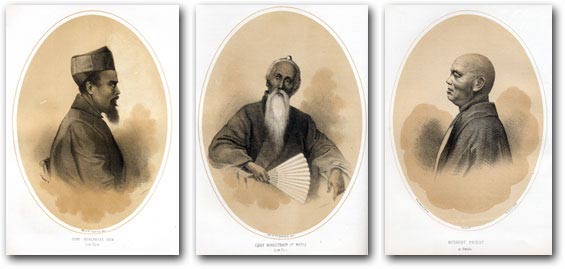 |
| Court
interpreter, Ryukyus |
 Chief
magistrate, Ryukyus Chief
magistrate, Ryukyus |
 Buddhist
priest Buddhist
priest |
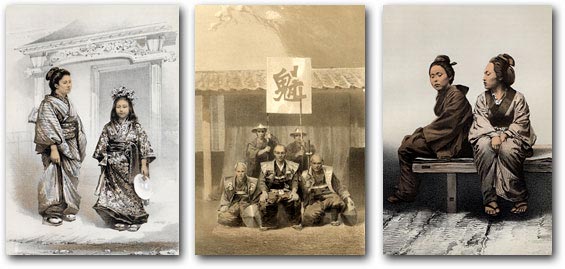 |
| Mother
and child, Shimoda |
 Prefect
of Shimoda Prefect
of Shimoda |
 Women,
Shimoda Women,
Shimoda |
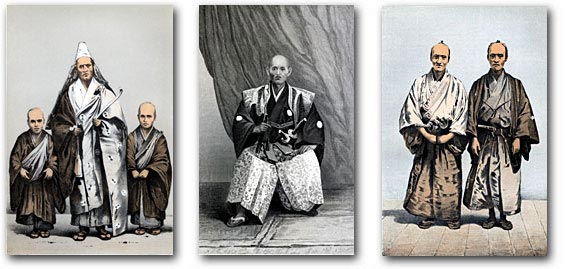 |
| “Priest
in Full Dress,” Shimoda |
 “Prince
of Izu” “Prince
of Izu” |
 Interpreters Interpreters |
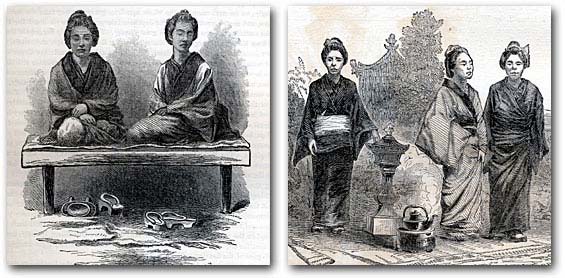 |
 Women
in Shimoda Women
in Shimoda
|
|
|

